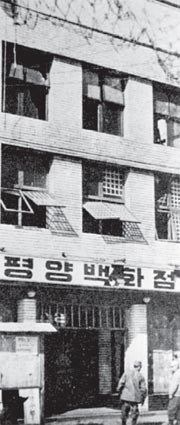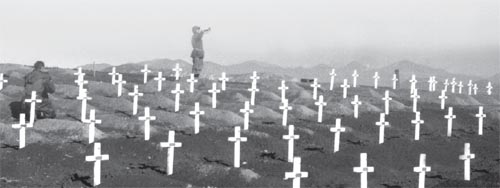THE LONG MARCH NORTH
Surveying the captured capital

The ROK and UN troops seized Pyongyang in October 1950. The city was in good condition at the time. [JoongAng Ilbo]
The enemy was in poor shape and looked to be on the verge of collapse. We moved into Pyongyang while the ROK 15th Regiment entered the city from the north. The ROK 15th Regiment had hastened the enemy’s retreat by attacking them from the rear.
The enemy troops were hiding throughout Pyongyang and I was busy directing my men. We had set up our command post at Shinri Elementary School. We were standing on the football field of the school one day when a line of vehicles entered the school’s grounds. Gen. Frank. W. Milburn was with the group. He approached me and said he was going to hold an awards ceremony.
“General Paik, congratulations on leading your men into Pyongyang,” he said. “On behalf of the American government, I present you with the Silver Star.”
It was the third highest military decoration by the U.S. Armed Forces for valor in the face of the enemy. He left immediately after and although I had been recognized by our allies for my work in combat, I wasn’t in a celebratory mood. After all, the war was not yet over and I had a lot of work to do.
We were getting daily reports from the ROK 15th Regiment that they were causing a lot of damage to the enemy troops from the rear. The enemy, or what remained of it in and around Pyongyang, were slowly but surely withdrawing north. Taking advantage of the situation, we began to target the civilians with posters and notes, alerting them of our presence in the city. They were told not to worry, now that the ROK Army was in the city.
The ROK 15th, 12th and 11th Regiments were carrying on with their tasks without much trouble. It was late at night when I, along with two of my officers, decided to visit the house my family had resided in.
I took two of my men and entered the room in which I spent my childhood. I spent the night there.
I was tired after what proved to be a long day, but had trouble falling asleep. Lying there in the very room where I had spent my youth, childhood memories of taking the streetcar with my brother to Taedong River filled my head. After a while, I also began to think about how the war would end, whether we could drive Kim Il Sung and his men out of the Korean Peninsula. I began to think back to the manner in which we entered Pyongyang. It was becoming clearer by the day that the enemy was crumbling and that meant we needed to pick up the pace and continue to press farther north. On the other hand, I also began to question whether the enemy would fall so easily. I became concerned that the ROK Army, along with the UN troops, were straying from the task at hand and were beginning to fall under the illusion that the war was all but over.
Even though we were in a favorable position, concerns over how our enemy would respond continued to gnaw at me. I wondered whether the Chinese People’s Army would sit idly by and continue to watch their North Korean allies get destroyed and whether they would get involved in the war.

A ceremony is held for fallen members of the U.S. Marine Corps, 1st Marine Division in South Hamgyong Province. [JoongAng Ilbo]
Unconcerned with such thoughts, the ROK and UN troops in Pyongyang were in a festive mood. The ROK Army was happy to have pushed the enemy troops out of their capital city and the U.S. troops, who wanted desperately to end the war as quickly as possible and return home, were equally ecstatic. The Americans were full of hope, having entered Pyongyang without much resistance, and were predicting an imminent victory.
As I began to fall asleep, I began to focus on our planned push north the next day.
I awoke the next morning at 6 a.m. When we arrived at our command post, we were greeted by the U.S. Army’s 2nd Infantry Division, numbering roughly 100 or so. Sent by the UN General Headquarters in Tokyo, Japan, the U.S. 2nd Infantry Division was in charge of intelligence gathering. They were looking to gather all the documents and files left behind by the enemy. They crossed the river ahead of us and we followed at around 10 a.m.
The fighting in the area, which had taken place up to a day prior to our arrival, had ceased. The enemy troops had mostly cleared from the area. I also came across Mansudae Assembly Hall, a national legislative building that housed Kim Il Sung’s office. Upon entering Kim’s office, the first thing that came to my sight was a portrait of Soviet leader Joseph Stalin (1878-1953). I walked towards Kim’s desk and sat in his chair. He probably devised the scheme to invade the south from this very chair. I found out at a later date, but we had missed-out on capturing him by just days. Kim fled Pyongyang four days prior to our arrival in the city.
After leaving the office, I got in my jeep and drove aimlessly around the city. It had not changed much since I left five years before. I noticed Pyongyang Station had been damaged by aerial bombing, but other parts of the city were intact, not affected by the war that had devastated parts of the south.
This is another anecdote from Pyongyang, heard from Col. Kim Jeom-gon of the 12th Regiment many years after the war: On the night of our arrival in Pyongyang, one of Colonel Kim’s men approached him with an idea. “Since we’re in Pyongyang, why don’t we check out the famous gisaeng house - a place with female entertainers - and see for ourselves if any changes took place?”
Despite the timing of it all, Colonel Kim succumbed to his officer’s urging and went to the gisaeng house.
Having lived on bad food and geonppang, or hardtack, on the battlefield, the colonel and his men ordered some greasy food to fill their stomachs. The Pyongan region’s dishes were not great, but good enough to tend to their hunger.
Then a group of female courtesans entered the room and Colonel Kim said he felt a bad vibe. They were wearing black traditional garbs down to their socks. It was in stark contrast to most gisaeng, who usually wore colorful hanbok, or traditional Korean clothing. After a few rounds of alcohol, the gisaeng began to speak out.
According to the colonel, they began to complain about the ways of the communists. The senior communist officials had ate and drank to their heart’s content and left without dropping a dime.
They had kept the gisaeng house open for their own personal pleasures, but due to the watchful eyes of the citizens who were suffering through a war, they had made the gisaengs dress in such a manner. Colonel Kim said he treated them that night and they ended up drinking more than the officers.
It was just one occasion, but it gave us a clear indication of the double standards of the North Korean communists.
Although Pyongyang looked fine on the exterior, there were definitely problems within the city. We made our way to the Pyongyang prison and saw a large number of corpses in the front yard. Before they hastily left the city, they had killed off as many prisoners as they could. As we made our way around the prison, we found corpses strewn about everywhere. Among the dead were those captured during the war from the south and those who had refused to withdraw with the enemy troops.
Having grown up in Pyongyang, I had witnessed first hand the methods of the communists and always saw them with disdain due to what seemed like their inhumane ways. The sight of the corpses strewn about reaffirmed my negative views.
Such incidents were not limited to Pyongyang. The ROK and UN troops witnessed similar incidents in other places as they advanced north. According to records, Wonsan Prison was another place where a massacre took place. ROK troops, which were advancing north, made a stop at Wonsan Prison in mid-October of 1950 and came across a grisly finding. Roughly 900 dead inmates were found. Of them, 550 were political prisoners.
The enemy had tied the men in groups of five to six with thick chains and shot them to death. The sight of the corpses - piled into an air-raid shelter - was said to have caused quite a bit of shock to those who made the gruesome discovery.
Hamhung Prison was much the same. The ROK troops had to fish bodies out of water wells and found ROK prisoners of war shot to death as well.
Such ruthless killings often brought about intense hatred for the opposing side and caused the bereaved family members to seek revenge. However, it was important for the government and the armed forces to try to subdue such behavior in an effort to put an end to senseless killings.
While we were busy trying to stop angry people from seeking revenge, the opposing side had killed prisoners of war and political prisoners at will.
My experience at the Pyongyang Prison made me mad, but such feelings did not last long as I had responsibilities to tend to.
We received orders to move onto Suncheon, Pyongan Province. The U.S. Airborne troops were to be deployed in the area to cut off retreating enemy soldiers.
We were to provide support and rescue prisoners of war and other captives. Our short-lived break was over and we were again in a rush to move onto our next mission.
60 years with the military, by Paik Sun-yup
Translation by Jason Kim [jason@joongang.co.kr]
아침 6시쯤 잠자리에서 일어났다. 사단 CP에 갔더니 미군들이 와 있었다. 미 2사단의 ‘인디언 헤드’ 마크를 단 사람들이었다. 100명 남짓이었다. “도강(渡江)을 허락해 달라”는 그들은 더글러스 맥아더 장군의 도쿄 유엔총사령부(GHQ)에서 보낸 ‘문서 수집반’이었다. 북한이 남기고 간 모든 문서를 신속하게 확보하기 위해 온 사람들이었다. 그들은 그렇게 부지런했다. 나는 “강을 넘어도 좋다”고 허락했다. 그들이 나보다 조금 앞서 먼저 강을 건넜다.
나는 오전 10시쯤 강을 넘었다. 강 건너편은 이미 국군과 미군에 의해 대부분 정리가 된 상태였다. 전날 저녁까지 일부 벌어지던 시가전은 모두 사라졌다. 북한군은 평양에서 거의 물러간 상태였다. 먼저, 김일성의 흔적을 찾았다. 만수대 인민위원회라고 하는 곳에 있는 그의 집무실에 들어섰다.
사무실에는 집기 등만이 그대로 있었다. 김일성의 집무실에 들어서는 순간 가장 먼저 눈에 띈 것은 소련 지도자 이오시프 스탈린의 초상이었다. 그 초상이 정문 맞은편 벽에 걸린 채 있었다. 사람의 온기라고는 전혀 없었다. 텅 비어 있는 사무실에 잠깐 서 있었다.
http://live.joins.com/news/article/article.asp?total_id=4142423










with the Korea JoongAng Daily
To write comments, please log in to one of the accounts.
Standards Board Policy (0/250자)